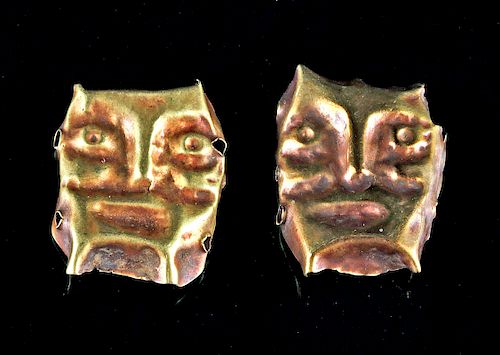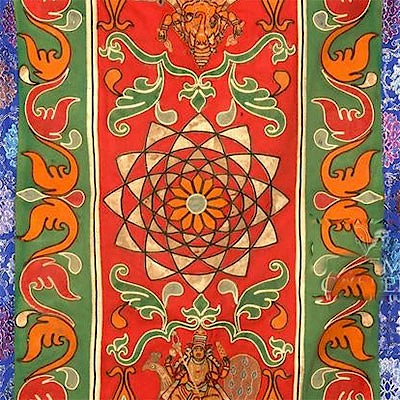Early Chavin Gold Trophy Head Beads - 2.2 g
Lot 430
About Seller
Artemis Gallery
686 S Taylor Ave, Ste 106
Louisville, CO 80027
United States
Selling antiquities, ancient and ethnographic art online since 1993, Artemis Gallery specializes in Classical Antiquities (Egyptian, Greek, Roman, Near Eastern), Asian, Pre-Columbian, African / Tribal / Oceanographic art. Our extensive inventory includes pottery, stone, metal, wood, glass and textil...Read more
Estimate:
$1,300 - $1,950
Absentee vs Live bid
Two ways to bid:
- Leave a max absentee bid and the platform will bid on your behalf up to your maximum bid during the live auction.
- Bid live during the auction and your bids will be submitted real-time to the auctioneer.
Bid Increments
| Price | Bid Increment |
|---|---|
| $0 | $25 |
| $300 | $50 |
| $1,000 | $100 |
| $2,000 | $250 |
| $5,000 | $500 |
| $10,000 | $1,000 |
| $20,000 | $2,500 |
| $50,000 | $5,000 |
| $100,000 | $10,000 |
| $200,000 | $20,000 |
About Auction
By Artemis Gallery
Oct 17, 2019
Set Reminder
2019-10-17 10:00:00
2019-10-17 10:00:00
America/New_York
Bidsquare
Bidsquare : Early Fall Variety | Ancient & Ethnographic
https://www.bidsquare.com/auctions/artemis-gallery/early-fall-variety-ancient-ethnographic-4538
Discover incredible lots relisted with new, lower start prices (up to 50% less), plus many items brand-new to auction. Step back in time and around the world – you’ll be amazed at the treasures you will find. Antiquities from the Classics, Asian, Pre-Columbian African and much more! Artemis Gallery info@artemisgallery.com
Discover incredible lots relisted with new, lower start prices (up to 50% less), plus many items brand-new to auction. Step back in time and around the world – you’ll be amazed at the treasures you will find. Antiquities from the Classics, Asian, Pre-Columbian African and much more! Artemis Gallery info@artemisgallery.com
- Lot Description
**Originally Listed At $650**
Pre-Columbian, North Coast Peru, Chavin, ca. 1000 to 500 BCE. Two highly-stylized anthropomorphic trophy head beads hammered in repousse from gold sheet comprised of 71% gold (equivalent to 15K+ gold). Each visage presents almond-shaped eyes with beady pupils beneath an arched browline, an aquiline nose, and stitched lips. The beads have been perforated thrice on each side. Beads like these examples represent some of the earliest gold work from the Andes. The first known extraction of ore comes from the Initial/Formative period, ca. 1800 to 900 BCE; during the Early Horizon (ca. 900 to 200 BCE) when these beads were made, the Andes were united under the cult propagated out of Chavin de Huantar. Examples of precious metalworking are quite rare and are almost exclusively crafted from gold. Size: each bead measures .875" L x .75" W (2.2 cm x 1.9 cm); Total weight: 2.2 grams
Mummified trophy heads date to the pre-ceramic period in ancient Peru. Head-taking was a significant component of their warfare and religious mythology. A warrior could increase his might and status by capturing prisoners for head-taking. According to scholar Paul A. Clifford, the fact that the lips of trophy heads are pinned shut " . . . implies that head-taking might mean the acquisition of a slain enemy's power or the prevention of his soul or spirit from harming the killer. Pinning lips shut on the trophy head could inhibit the loss of the soul or power embodied within the head." (cf. Art of the Andes: Pre-Columbian Sculptured and Painted Ceramics from the Arthur M. Sackler Collections, The Arthur M. Sackler Foundation: Washington D.C., 1983, p. 251.)
Provenance: private Hawaii, USA collection
All items legal to buy/sell under U.S. Statute covering cultural patrimony Code 2600, CHAPTER 14, and are guaranteed to be as described or your money back.
A Certificate of Authenticity will accompany all winning bids.
We ship worldwide and handle all shipping in-house for your convenience.
#144587Normal indentations and some tears to peripheries as shown. Red cinnabar in recesses. Gold has developed a beautiful warm patina.Condition
- Shipping Info
-
All shipping is handled in-house for your convenience. Your invoice from Artemis Gallery will include shipping calculation instructions. If in doubt, please inquire BEFORE bidding for estimated shipping costs for individual items.
-
- Buyer's Premium



 EUR
EUR CAD
CAD AUD
AUD GBP
GBP MXN
MXN HKD
HKD CNY
CNY MYR
MYR SEK
SEK SGD
SGD CHF
CHF THB
THB












